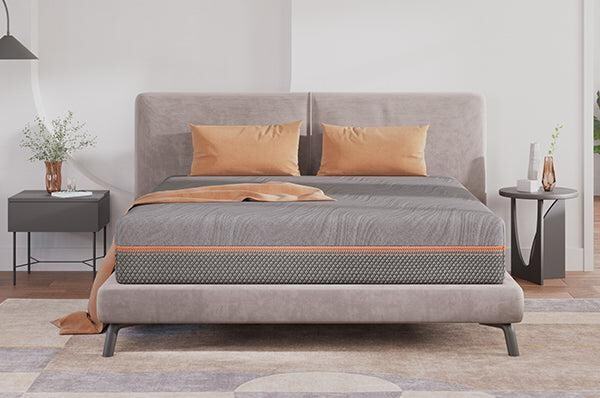Memory foam mattress is one of the most sought-after on the market today. This type of mattress owes its origin to the space race in the 1960s and was developed by NASA engineers for their spaceships. Memory foam is known for how it “molds” to your body, which feels incredible when you sleep on it.
On the other hand, spring mattress is hands down the most popular choice for mattress seekers. The invention of spring mattress precedes memory foam. However, it does not mean one is more advanced than the other. The two types of mattresses differ vastly in how they feel. Memory foam mattresses can conform to the body, while the spring mattresses offer a more “bouncy” kind of support.
Both memory foam mattresses and spring mattresses have their drawbacks and benefits, and each needs to be weighed carefully. This is because poor sleeping conditions lead to body aches, impaired concentration, and in extreme cases, even depression and anxiety.
On average, people spend around 26 years of their entire life in bed. Sleep experts highly recommend that you observe your sleeping patterns and preferences. If you’re not sure whether to go with a memory foam mattress or a spring mattress when you buy a new mattress, read on to learn more.
What is memory foam mattress?
Memory foam mattresses are made of several layers of foam. As a whole, these layers mold to your body and create bedding that is equally elastic and soft to the touch. Memory foam is known for its benefits such as weight distribution, but also its drawbacks such as heat-absorption. These mattresses are available in the following types:
Traditional memory foam
Traditional memory foam mattresses are built with polyurethane foam that has a closed cell structure. This closed cell structure is notorious for trapping heat and creating a hot sleeping experience. But because of the absence of springs inside the bed, these mattresses are softer than other types.
Gel-infused memory foam
Gel-infused memory foam mattresses are infused with a gel coolant, which creates a significantly cooler surface than traditional memory foam. This is especially suitable for people who sleep in warmer conditions. By design, this cooling feature makes these mattresses more expensive than traditional memory foam.
Plant-based memory foam
Plant-based memory foam uses plant-based material and is the most environmental-friendly of all the types of memory foam mattresses. This type of memory foam uses an open-cell structure that allows heat to escape, making the mattress more breathable. It’s typically soft to medium in firmness, which means you will not sink into it as you would in a traditional memory foam mattress. Due to its material and manufacturing process, it is relatively more expensive compared to the other two types of memory foam mattresses.
What is a spring mattress?
Spring mattresses, also known as innerspring mattresses, are the most traditional. This type of mattress is typically soft and more suitable for people with lower back pain. If you’re not satisfied with the support of a memory foam mattress, a spring mattress can be an ideal choice.
A spring mattress mainly consists of springs and fillers. To judge the quality of a particular spring mattress, knowing how the spring system inside of it works and what materials are used is important.
Types of spring systems
Different types of box spring mattresses can be identified by the coils or springs used. As a general rule, thicker coils mean a firmer mattress. Thinner coils are less sturdy, but more effectively contour to your body. The five different types of innerspring include:
Bonnell coil
Also known as hourglass coils, these coils are the cheapest and are generally less durable.
Offset coil
The individual coils are tightly bound together to form a coil layer that provides firm support for the mattress. These mattresses are durable, but can transfer motion. This means that tiny movements can be felt throughout the surface of the bed, making this type of mattress a potentially undesirable choice for couples.
Continuous coil
Continuous coils are twisted into thousands of coils to form a support layer, making the mattress durable. However, it also transfers motion like offset coils.
Pocket coil
Pocketed coil mattresses contain innerspring coils that are individually wrapped in fabric. The individual wraps provide motion isolation, which means it provides all the benefits of a standard coil mattress without much of the downside. This type of mattress uses more advanced technology than other spring mattresses, making it generally the most expensive type of spring mattress.
Coil-on-coil
Mattresses that use this coil system contain two layers of coils stacked on top of each other. This reduces bounce while also increasing support.
Key differences between memory foam mattresses and spring mattresses
You can see a comparison of the two types of mattresses in the table below:
| Feature | Memory Foam Mattress | Spring Mattress |
| Durability | Lasts 8-12 years | Lasts 5-8 years |
| Support | ·Conforms to body shape·Evenly supports the entire body | ·Firmer support·Support is unevenly distributed throughout the body |
| Bounce | Minimal bounce | High bounce |
| Pressure relief | Good pressure relief | Low pressure relief |
| Motion isolation | Good motion isolation | Poor motion isolation |
| Temperature-regulation | Traditional memory foam traps heat | Good temperature regulation and airflow |
| Sleep Position | Great for all sleep positions | Recommended for back and side sleepers |
| Price | Wide price range depending on materials used | Generally less expensive than memory foam |

There are fundamental differences between memory foam mattresses and spring mattresses. As there is no “one-size-fits-all” mattress that works best for all sleepers, you must keep in mind your sleeping habits and preferences when choosing a new mattress. Here are 5 factors to consider:
Whether you prefer body-conforming or bounce
Some people like the snug feel of memory foam, while others prefer the excellent bounce that springs provide. Whether you prefer one over the other is up to you. There is no right or wrong answer.
Whether you are a hot sleeper
In terms of breathability, spring mattresses generally perform better than memory foam mattresses. Traditional memory foam mattresses are not breathable and are generally inferior to mattresses that use layered coil systems, which allow ample airflow inside the mattress. However, modern gel-infused memory foam mattresses have gotten better with temperature regulation over the years.
Whether you share a bed with a partner or not
A major advantage of memory foam mattresses is their ability to isolate motion transfer. This means that if you sleep next to a partner, you will not feel any bounce caused by the other tossing and turning in bed. However, spring mattresses with pocketed coils can also isolate motion and minimize disturbance, albeit to a lesser degree.
Whether you have a medical condition such as back pain
Memory foam mattresses have long been used in medical settings to treat people with back pain or poor spinal alignment. However, if you do not have these medical conditions, you may benefit more from a spring mattress due to its firmness and more durable support layer.
What kind of budget you have
Typically, memory foam mattresses are priced higher than spring mattresses due to their high cost of materials.
Conclusion
While picking the right mattress might seem like a long journey, it doesn’t require more than a few minutes of research or actual testing. Both memory foam mattress and spring mattress have their pros and cons, so be sure to consider everything discussed above. However, if you want something in between, you may want to opt for a hybrid mattress that combines the benefits of both into one.
Source from Sweetnight
Disclaimer: The information set forth above is provided by Sweetnight independently of Alibaba.com. Alibaba.com makes no representation and warranties as to the quality and reliability of the seller and products.




